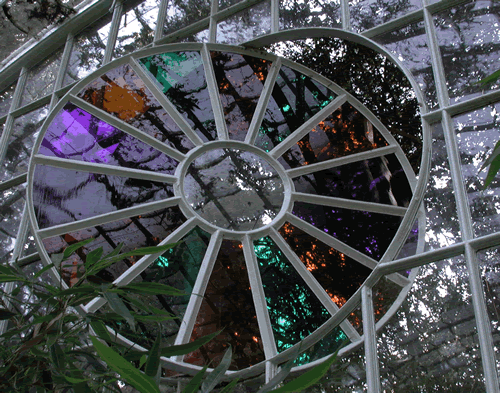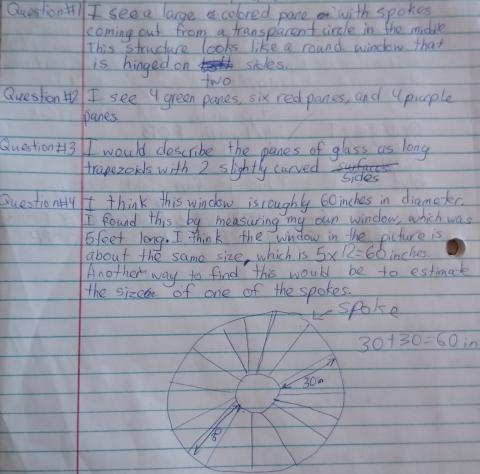Circle panes
Problem

Look carefully at the photo above, what do you see? What questions would you like to ask?
How many of each coloured pane are there?
How would you describe the shape of the coloured panes of glass?
How big do you think this window is?
In how many different ways could you make a sensible estimate of its size?
Talk about the different options with someone else.
You may like to use whatever you like to make a drawing similar to what you see in the picture.
Getting Started
How would you describe the photo to someone else who can't see it?
How could you be more precise in your description?
What else can you see in the photo which might give some clues as to the size of the window?
Student Solutions
Well done to everybody who looked carefully at the picture and shared their ideas with us.
Akira from Sahuaro Elementary School in the USA sent in these thoughts:
I noticed that the circle pane is facing a different direction than the rest of the panes.
I wonder how many panes there would be on the circle if the circle was a sphere.
I would describe the colour of the panes as very bright and you can see through it.
I believe that there are 3 different types of colours purple, orange and green.
When I looked at the picture I noticed the leaves seemed very huge and that the building was two times the height of the leaves.
Good ideas, Akira. Anna, also from Sahuaro Elementary School, sent in an answer to each of our questions:
(A) When I look at the photo I see the reflection of the trees and the different colored glass, I also see the window with 14 slots in it.
(B) Some questions I would like to ask are, is the window built at that angle or does it rotate, and are the different colors in the glass actually colored or is it a reflection.
(C) I see 14 panes in the window.
(D) I would describe the shape of the coloured panes like a pie slice with a flat end.
(E) I think the window is about 6ft tall and 6ft across.
(F) A few ways you could find a sensible size of the window is by measuring the panes adding two of them and 1ft for the circle in the middle, another way is to measure the width and length of the building then measuring how far from the edges the window starts and subtract that from the length and width.
(G) I talk to my friend about my ideas and she says that they are great and will probably work.
Thank you for sending in these ideas, Anna. I like your idea of thinking of each pane as a pie slice! I wonder if the end of each 'slice' is actually flat?
Theo from Pierrepont Gamston Primary School in England sent us his thoughts about the window:
There are four of each coloured panes (green, purple, orange and blue). The shape of them look like an irregular trapezium. I think the size is 5 feet tall and wide. To make a sensible estimate you could use the size of rectangular windows and trees reflecting it or a rough estimate of the size of its panes. The rectangular windows around are smaller, and you can guess that they are a bit smaller than normal windows but not really small.
Good ideas, Theo - we can use the windows around it or the trees in the reflection to come up with an estimate of the size of this window.
I can't tell exactly how many of each coloured pane there are, but I know that actually there can't be four of each of the four colours. How do I know this?
Toby from Pierrepont Gamston Primary School said:
I can see a glass pane placed in between a circle. A question I would like to ask is... why is it like that? Is it meant to be placed in that way? I would describe it as a mis-placed glass pane split into 14 places each having a colour inside of them. I think it's 1.5 metres in length and width (because it's a regular circle).
You could compare it to one of the leaves on the tree. You would then find the average length and width of an average leaf. You would then estimate how many leaves would fit into a singular glass pane. You could also roughly estimate the how big it is compared to a normal glass panel. This could look different compared to another because of how far away the photo was taken from.
Well done Toby, I like your idea of finding the average size of a leaf and then using this to estimate the size of the window!
Keerthana agreed with Theo that each of the coloured panes looks a bit like a trapezium. She sent in these answers to our questions:

Good ideas, Keerthana. I like the way you measured your own window to get an idea of how wide the window in the picture might be.
Ci Hui Minh Ngoc from Kelvin Grove State College in Brisbane, Australia thought about this problem in a different way. They found two different ways of estimating the area of the window, and used some algebra to explain their ideas. Take a look at Ci Hui Minh Ngoc's full solution to see how they did it. For each of these methods, we need to know the width of the window in order to work out the area - how could we estimate how wide the window is?
Teachers' Resources
Why do this problem?
This task gives learners the chance to describe an image, using both mathematical and everyday language. The challenge of estimating the size of the window in different ways will encourage children to draw on their own experiences and make comparisons. By engaging with this problem, learners may be inspired to notice mathematics in the world around them more generally.
Possible approach
Show the photograph and invite learners to consider what they see, and what questions they would like to ask. After a few moments of silent thinking time, suggest that they talk with a partner. Bring everyone together to share their thoughts and collate a list of questions on the board which you can return to later. Encourage other members of the class to respond to the contributions rather than you validating everything that is said. At this point, learners may well use a mixture of mathematical terms and everyday language, which is very appropriate in this situation.
If it does not come up naturally, you could specifically ask about the number of coloured panes, and ways that the shape of the panes can be described. There is no mathematical term for the shape, but encourage learners to distinguish between straight and curved sides, and they may liken the shape to something else. If pupils are curious, you may wish to introduce the term 'sector', which is the area of a circle enclosed by two radii and the circumference (like the shape we often draw to represent a slice of pizza or a slice of cake), but this is certainly not obligatory! In this image, the coloured panes are not 'sectors' as each pane does not extend to the centre of the circle, but your class may come up with some informal language to describe the shape. You may wish to challenge them to describe the image to someone in another class, or another adult, who has not seen the photo. Can that person re-create the picture from just the pupils' description?
Give pupils time in pairs to think about different ways of estimating the size of the window. As they work, listen out for those who are using other items in the photo to try to get a sense of relative size, for example the leaves or the reflections that are visible. You can invite some pairs to share their thinking in the final plenary. As a simmering task (to work on over an extended period of time) you could invite learners to follow up one of the questions that was asked at the start of the lesson and then dedicate some time at a later stage for sharing findings.
Key questions
How would you describe the photo to someone else who can't see it?
How could you be more precise in your description?
What else can you see in the photo which might give some clues as to the size of the window?
Possible support
Allow learners to use gesticulation at first to help them describe what they see - this may help you focus your support in terms of vocabulary development. As they consider how to estimate the size of the window, encourage learners to look around them, both inside and outside the classroom, to identify known sizes of particular objects for comparison.
Possible extension
You could ask learners to explore the symmetry in the window.
